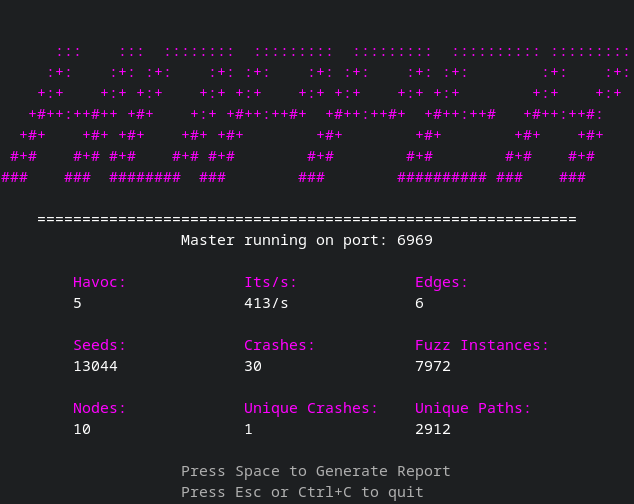Hopper aims to improve performance of Fuzzing in large-scale distributed environments, it's not meant to replace AFL++ in most cases.
Hopper Master
- LLVM toolchain, specifically clang with it's built-in ASAN
- clang-tools, SanitizerCoverage sancov utility.
- The compile script adds all the flags required to compile the target program with clang++.
Ex:
./compile target.c
HOPPER_OUT: Where to save Hopper output; sanitizer reports, crash inputs and hopper reports, defaults to.HOPPER_LOG: Enable Logging on Master, defaults toHOPPER_LOG=0Master onlyHOPPER_LOG_INTERVAL: Logging interval in minutes, defaults toHOPPER_LOG_INTERVAL=30(ignored ifHOPPER_LOGis not set) Master only
- -I: Path to input corpus, directory containing files each being a seed
- -H: Havoc level to use in mutator, defaults to
1(recommended: increase havoc for larger seeds) - -P: Port to host Master on, defaults to
6969
Ex:
go build ./cmd/hopper-master && ./hopper-master -H 5 -I test/in
- -I: Node ID, usually just a unique int
- -T: Path to instrumented target binary
- -M: IP/address of Master, defaults to
localhost - -P: Port of Master, defaults to
6969 - --raw: Should seed be fed directly in the run command, defaults to
false. Hopper will put bytes in a file and feed that file to target. - --args: Args to use against target, ex:
--depth=1 @@ - --env: Env variables for target seperated by a
;, ex:ENV1=foo;ENV2=bar; - --stdin: Should seed be fed as stdin or as an argument, defaults
to
false
Ex:
Args:
go build ./cmd/hopper-node; ./hopper-node -I 1 -T target --args "--depth=2 @@"Stdin:
go build ./cmd/hopper-node; ./hopper-node -I 1 -T target --stdin
You can also look at all the Hopper containers running by doing: docker ps -f "name=hopper"
Hopper running locally with 10 fuzzing Nodes, fuzzing a test application with a known vulnerability:
- Clone project:
git clone https://github.com/Cybergenik/hopper.git && cd hopper - Build base Hopper image:
docker build -t hopper-node . - Run Master:
./examples/parse/docker/master_docker.sh - Run Nodes:
./examples/parse/docker/node_docker.sh 1 10(I'd recommend no more than 1x # of logical cores on your machine, any more nodes on one system and they just get throttled and competing for CPU time) - Look at the nice TUI :>
Hopper running locally with 10 fuzzing Nodes, fuzzing GNU binutils-2.40 readelf:
- Clone project:
git clone https://github.com/Cybergenik/hopper.git && cd hopper - Build base Hopper image:
docker build -t hopper-node . - Build readelf image:
docker build -t hopper-readelf ./examples/binutils/ - Run Master:
./examples/binutils/readelf/master_docker.sh - Run Nodes:
./examples/binutils/readelf/node_docker.sh 1 10(I'd recommend no more than 1x # of logical cores on your machine, any more nodes on one system and they just get throttled and competing for CPU time) - Look at the nice TUI :>
The Masters job is to schedule fuzz tasks on Nodes in the cluster, keep track of coverage, mutate seeds, and produce reports. The Master handles all these responsibilities concurrently. There are two main processes running concurrently on the Master, an RPC server and the Mutation Engine.
Hopper uses a bloom filter to keep track of coverage and to deduplicate seeds based on coverage and content.
The mutation engine acts as a load balancer by popping energized seeds from the energy priority queue (EPQ), mutating them, and feeding newly formed seeds to the task queue. The Mutation Engine only mutates when there’s enough space in the Task Queue for more tasks, otherwise it stalls. Because a single energized seed can turn into tens of seeds, this can be seen as an inverse funnel, thus the Mutation Engine has some control of flow through the system.
A Hopper Node’s job is to run the PUT, gather and parse coverage, and report coverage/crash data to the Master. Each Node runs a main Fuzz loop. Nodes are fairly synchronous, with a few sections of parallelism for logging crashes and clean-up. But generally we keep each instantiation of a Node synchronous such that we can more easily reason about it as a discrete unit of computation.



